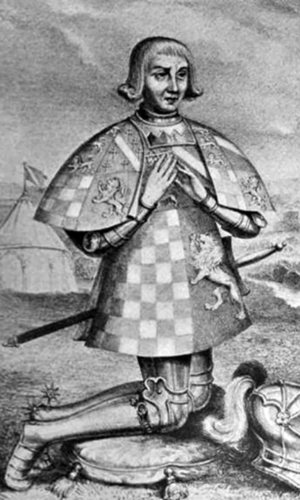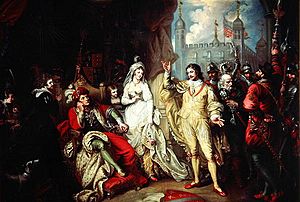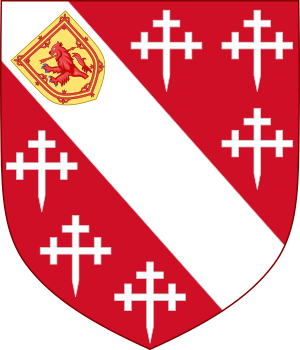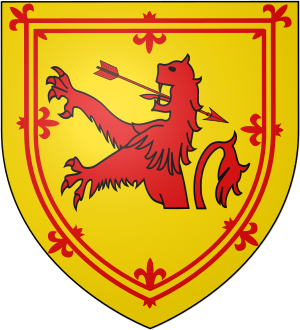Thomas Howard, 2nd Duke of Norfolk facts for kids
Quick facts for kids
The Duke of Norfolk
|
|
|---|---|

1907 copy of a contemporary depiction
|
|
| Lord High Treasurer | |
| In office 16 June 1501 – 4 December 1522 |
|
| Monarch | Henry VII Henry VIII |
| Preceded by | John Dynham, 1st Baron Dynham |
| Succeeded by | Thomas Howard, 3rd Duke of Norfolk |
| Earl Marshal | |
| In office 1509–1524 |
|
| Preceded by | The Duke of York |
| Succeeded by | The Duke of Suffolk |
| Member of the House of Lords Lord Temporal |
|
| In office 1514 – 21 May 1524 Hereditary Peerage |
|
| Preceded by | The 1st Duke of Norfolk |
| Succeeded by | The 3rd Duke of Norfolk |
| Personal details | |
| Born | 1443 Stoke-by-Nayland, Suffolk |
| Died | 21 May 1524 (aged 80–81) Framlingham Castle, Suffolk |
| Spouses |
|
| Children | Thomas Howard, 3rd Duke of Norfolk Sir Edward Howard Lord Edmund Howard Elizabeth Boleyn, Countess of Wiltshire William Howard, 1st Baron Howard of Effingham Lord Thomas Howard Dorothy Stanley, Countess of Derby 11 more |
| Parents |
|
Thomas Howard, 2nd Duke of Norfolk (1443 – 21 May 1524) was an important English nobleman, soldier, and politician. He served four different kings during his long life. He was the oldest son of John Howard, 1st Duke of Norfolk.
Thomas Howard was also the grandfather of two queens: Anne Boleyn and Catherine Howard. He was even the great-grandfather of Queen Elizabeth I. In 1513, he led the English army to a big victory against the Scots at the Battle of Flodden. King Henry VIII, who was in France at the time, rewarded him greatly for this success.
Contents
Early Life and Education
Thomas Howard was born in 1443 in a place called Stoke-by-Nayland in Suffolk, England. He was the only son of John Howard and his first wife, Katherine. Thomas went to school at Thetford Grammar School.
Serving King Edward IV
When he was young, Thomas Howard started working for King Edward IV. He was a loyal supporter of the King. In 1469, when a war began with the Earl of Warwick, Howard stayed on the King's side.
When King Edward had to flee to Holland in 1470, Howard found safety in Colchester. He rejoined the King's army when Edward returned to England in 1471. Howard was badly hurt at the Battle of Barnet on April 14, 1471. In 1473, he became an esquire of the body, a personal attendant to the King. On January 14, 1478, King Edward IV made him a knight. This happened at the wedding of the King's second son, the young Duke of York.
Loyalty to King Richard III
After King Edward IV died on April 9, 1483, Thomas Howard and his father, John, supported the new King, Richard III. Thomas carried the Sword of State at Richard's coronation. He also helped manage the coronation feast.
King Richard gave both Thomas and his father land and money. On June 28, 1483, John Howard became the Duke of Norfolk. Thomas was given the title of Earl of Surrey. Surrey also joined the King's special advisory group, the Privy Council. He was also made a Knight of the Order of the Garter. Later that year, the Howards helped stop a rebellion against the King.
Both Howards stayed close to King Richard during his two-year reign. They fought for him at the Battle of Bosworth in 1485. In this battle, Surrey was wounded and captured, and his father was killed. The new King, Henry VII, took away Surrey's lands and put him in the Tower of London. He stayed there for three years.
Service Under King Henry VII

While in prison, Thomas Howard had a chance to escape during a rebellion in 1487. But he refused to leave. This likely showed King Henry VII that he was loyal. In May 1489, King Henry gave him back his title of earldom of Surrey. However, he kept most of Surrey's lands.
The King then sent Surrey to stop a rebellion in Yorkshire. Surrey stayed in the north as the King's representative until 1499. He and his family lived in Sheriff Hutton Castle during this time. In 1499, he was called back to court. The next year, he went with the King on a trip to France.
In 1501, he became a member of the Privy Council again. On June 16, 1501, he was made Lord High Treasurer, a very important financial role. Surrey, along with two other key figures, became the King's main advisors. He also handled several important diplomatic tasks. In 1501, he helped with the plans for Catherine of Aragon's marriage to Arthur, Prince of Wales. In 1503, he escorted Margaret Tudor to Scotland for her wedding to King James IV.
Serving King Henry VIII

When King Henry VII died on April 21, 1509, Surrey was one of the people in charge of carrying out his will. He played a big part in the coronation of the new King, Henry VIII. In this ceremony, he served as Earl Marshal.
Surrey wanted to be the new King's chief minister. But he eventually accepted that Thomas Wolsey would hold that position. Surrey expected to lead the English army to France in 1513. However, the King left without him on June 30, 1513.
Soon after, King James IV of Scotland invaded England. Surrey, with the help of other nobles and his sons Thomas and Edmund, defeated James's much larger army. This happened at the Battle of Flodden, near Branxton, Northumberland, on September 9, 1513. The Scots lost many soldiers, and King James was killed.
The victory at Flodden made Surrey very famous and brought him many rewards from the King. On February 1, 1514, at 71 years old, he was made the 2nd Duke of Norfolk. This was his late father's title. His son Thomas became the Earl of Surrey. Both received land and money. The Howard family crest was also changed to honor the Flodden victory. A special symbol was added: a lion of Scotland with an arrow through its mouth. This was a clear message to the Scottish kings.
Later Years and Legacy
In the last ten years of his life, Norfolk continued to work as a courtier, diplomat, and soldier. In 1514, he helped negotiate the marriage of Mary Tudor to King Louis XII of France. He also escorted her to France for the wedding.
On May 1, 1517, he led a private army into London to stop the Evil May Day riots. In May 1521, he oversaw the trial of his relative Edward Stafford, 3rd Duke of Buckingham. He delivered the death sentence with tears in his eyes.
By the spring of 1522, Norfolk was nearly 80 years old and not in good health. He left the royal court. He resigned as Lord Treasurer in December of that year, giving the role to his son. After attending the opening of Parliament in April 1523, he retired to his castle at Framlingham in Suffolk. He died there on May 21, 1524.
His funeral and burial on June 22 at Thetford Priory were very grand and expensive. They cost over £1300. The procession included 400 men with torches and a fancy display with many wax figures and candles. This was fitting for the richest and most powerful noble in England. After the priory was closed down, the Howard family tombs were moved to the Church of St Michael the Archangel, Framlingham.
Family and Children
On April 30, 1472, Thomas Howard married Elizabeth Tilney. She was the daughter of Sir Frederick Tilney. They had several children, including:
- Thomas Howard, 3rd Duke of Norfolk
- Sir Edward Howard
- Lord Edmund Howard, who was the father of King Henry VIII's fifth Queen, Catherine Howard
- Elizabeth Howard, who married Thomas Boleyn, 1st Earl of Wiltshire. She was the mother of Queen Anne Boleyn and grandmother of Queen Elizabeth.
- Muriel Howard (died 1512)
Norfolk's first wife died on April 4, 1497. On November 8, 1497, he married her cousin, Agnes Tilney. They also had children, including:
- William Howard, 1st Baron Howard of Effingham
- Lord Thomas Howard (1511–1537)
- Dorothy Howard, who married Edward Stanley, 3rd Earl of Derby
- Anne Howard, who married John de Vere, 14th Earl of Oxford
- Catherine Howard
- Elizabeth Howard (died 1536)


